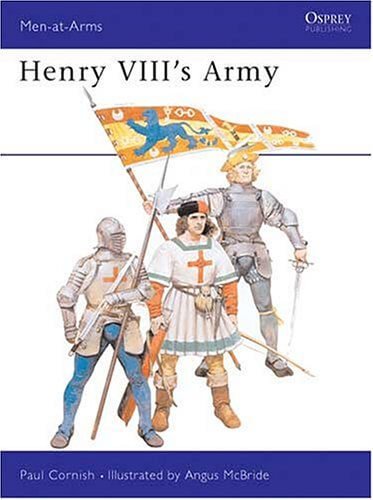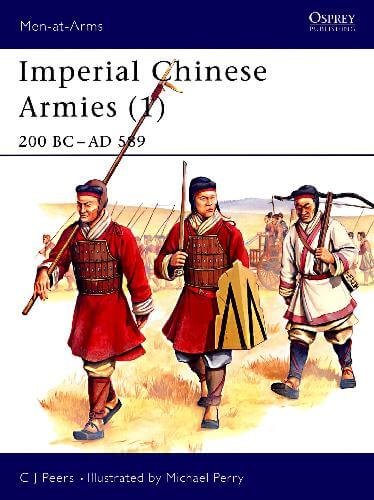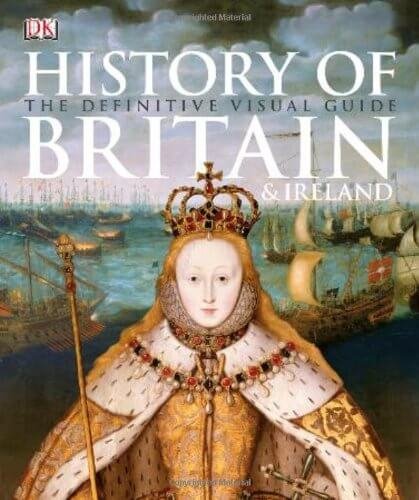“Henry VIII’s Army” by Paul Cornish & Angus McBride
Tudor Warfare: From Flodden to the French Campaigns
Overview
Authored by military historian Paul Cornish and illustrated by Angus McBride, this volume from Osprey’s Men-at-Arms series explores the military machinery of Tudor England under Henry VIII (1491–1547). Combining archival research, tactical analysis, and McBride’s vivid reconstructions, the book dismantles stereotypes of Tudor armies as feudal relics, revealing their strategic innovation, technological adaptation, and logistical complexity. Rated 4.0/5.0, it serves as a visual and scholarly guide to England’s campaigns against France and Scotland, contextualizing Henry’s ambition to dominate European politics.
Key Features
- Strategic Ambitions & Rivalries
- France as the “Principal Foe”: Henry VIII sought to revive England’s medieval claims to the French throne, aligning with Habsburg Spain against François I. Major campaigns included the 1513 Battle of the Spurs (Guînes) and the 1544 Siege of Boulogne.
- Scottish Border Wars: Henry’s northern armies clashed with Scotland at Flodden Field (1513), where English longbowmen and billmen annihilated James IV’s forces, marking the last medieval-style battle in Britain.
- Military Reforms & Forces
- Mercenary Armies: Tudor England lacked a standing army. Henry relied on German Landsknechte and Spanish arquebusiers for continental campaigns, while recruiting local militias for border defense.
- Artillery Revolution: Henry imported bronze cannons from Flanders and established foundries at London’s Tower Armouries. His flagship Mary Rose (sunk 1545) carried 91 guns, including anti-personnel murderers and ship-sinking demi-cannon.
- Uniforms & Equipment
- Billmen & Longbowmen: Core infantry wielded 6-foot bills (hook-bladed polearms) and yew longbows (range: 250 yards). McBride’s Plate A1 depicts a 1513 billman in padded jack and sallet helmet.
- Early Firearms: By the 1540s, arquebusiers (Plate B3) in brigandine armor supplemented traditional forces. Henry’s arsenal stored 6,500 muskets and 2,250 cannons by 1535.
- Naval Dominance
- Royal Navy Expansion: Henry inherited 15 ships but built a fleet of 53 vessels, including the 1,000-ton Henry Grace à Dieu (1514). Dockyards at Deptford and Woolwich became hubs for hybrid carrack-galleon warships.
- Privateering Culture: To disrupt French trade, Henry licensed pirates like William Hawkins, whose raids on Spanish treasure ships prefigured Elizabethan privateers.
Translation with Contextual Additions
(Original Text Translated and Enhanced for Global Audiences)
Title: Henry VIII’s Army
Authors: Paul Cornish (text), Angus McBride (illustrations)
Format: Paperback
Rating: 4.0/5.0 (0 reviews)
Full Description:
Cornish’s analysis redefines Henry VIII as a military modernizer who balanced medieval chivalry with Renaissance pragmatism. The book highlights pivotal clashes like the 1545 Battle of the Solent, where English galleasses outmaneuvered French galleys, while McBride’s 8 full-page plates—based on artifacts like the Greenwich Armour and Mary Rose wreck—revive figures such as a Tudor artillery captain (Plate C2) directing a bronze falconet and a Border Reiver (Plate D1) raiding Scottish lowlands.
Key Enhancements for Clarity:
- Geopolitical Context: Explains Henry’s alliance-shifting between Habsburgs and Valois, driven by rivalry over trade routes and dynastic prestige.
- Ethical Debates: Challenges the myth of Tudor “backwardness” by detailing Henry’s adoption of Italian fortification designs (e.g., Device Forts) and German mercenary contracts.
- Legacy: Traces Henry’s military reforms to Elizabethan triumphs (e.g., the 1588 Spanish Armada) and the rise of England as a naval superpower.
Why Western Readers Should Care:
- Complements Osprey’s The Army of Francis I (MAA 330) for understanding 16th-century Anglo-French rivalry.
- Bridges academic studies (e.g., David Loades’ The Tudor Navy) with visual storytelling, ideal for reenactors and history enthusiasts.
Visual & Academic Enhancements
- McBride’s Artistry: Plates include a Tudor siege engineer (Plate B1) using geometric tools from Niccolò Tartaglia’s treatises, and a Yeoman of the Guard (Plate A3) in Henry’s livery of green and white.
- Archaeological Fidelity: Drawings reference the Mary Rose’s preserved longbows and Greenwich Armouries’ brigandines, ensuring historical accuracy.







评价
目前还没有评价